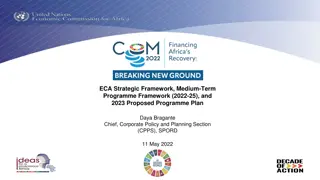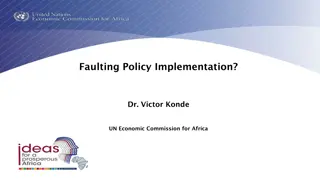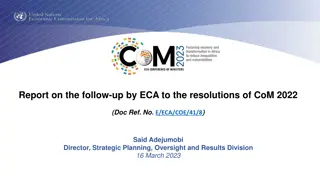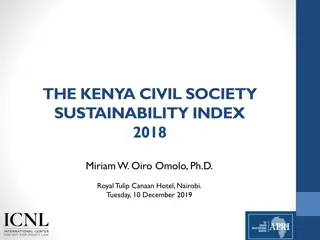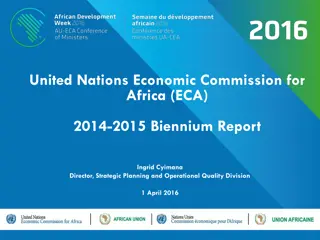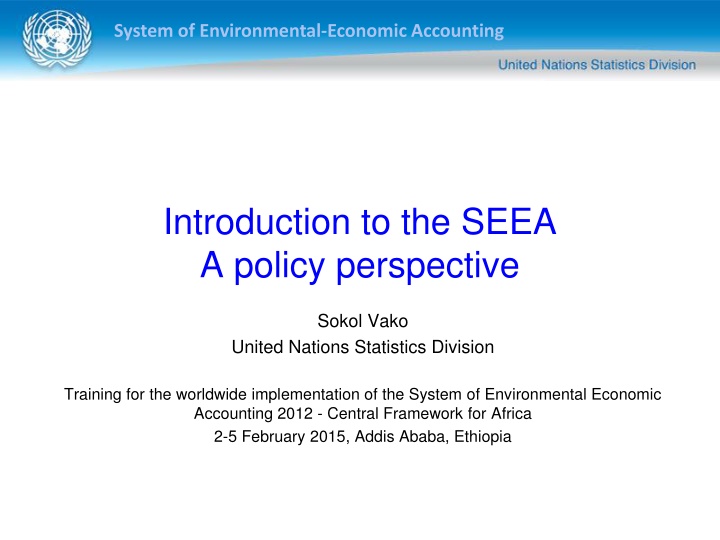
Environmental-Economic Accounting: A Policy Perspective and Implementation Overview
Explore the System of Environmental-Economic Accounting (SEEA) as an internationally agreed statistical framework to measure the environment's interactions with the economy. Learn about its adoption as a standard, policy settings, and the importance of integrating environmental and economic data for informed decision-making.
Download Presentation

Please find below an Image/Link to download the presentation.
The content on the website is provided AS IS for your information and personal use only. It may not be sold, licensed, or shared on other websites without obtaining consent from the author. If you encounter any issues during the download, it is possible that the publisher has removed the file from their server.
You are allowed to download the files provided on this website for personal or commercial use, subject to the condition that they are used lawfully. All files are the property of their respective owners.
The content on the website is provided AS IS for your information and personal use only. It may not be sold, licensed, or shared on other websites without obtaining consent from the author.
E N D
Presentation Transcript
System of Environmental-Economic Accounting Introduction to the SEEA A policy perspective Sokol Vako United Nations Statistics Division Training for the worldwide implementation of the System of Environmental Economic Accounting 2012 - Central Framework for Africa 2-5 February 2015, Addis Ababa, Ethiopia
System of Environmental-Economic Accounting Policy settings Post-2015 UN development agenda/SDGs Green Growth/Green Economy Broader measures of progress/Beyond GDP Natural Capital Accounting/ WAVES Aichi targets (e.g. Target 2) Poverty and environment TEEB
System of Environmental-Economic Accounting SEEA Internationally agreed statistical framework to measure environment and its interactions with economy Adopted as international statistical standard by UN Statistical Commission in 2012 Developed through inter- governmental process Published by UN, EU, FAO, IMF, OECD, WB
System of Environmental-Economic Accounting SEEA: A Statistical Standard Countries are encouraged to implement the standard International organizations have obligations to assist countries in implementation Implementation strategy adopted by Statistical Commission in March 2013 Data reporting mechanism will be established
System of Environmental-Economic Accounting The Suite of SEEAs Handbook interim publication Updated SEEA handbook manual of best practices UNSC decided to elevate SEEA to an international standard 1993 2003 2006 2012 2013 2013 SEEA The Central Framework (international standard) SEEA Experimental Ecosystem Accounting SEEA Applications and Extensions Subsystems: SEEA Water (adopted in 2007) SEEA Energy SEEA Agriculture
System of Environmental-Economic Accounting Information is vital and it needs to be integrated The economy impacts on the environment and the environment impacts on the economy To understand these linkages we need to integrate environmental and economic information This is the explicit purpose of the SEEA
System of Environmental-Economic Accounting Integrated statistics Linking policy needs and statistics Understanding the institutional arrangements Integrated statistical production process/chain and services Consistency between basic data, accounts and tables and indicators Indicators Accounts SEEA Basic data Economic Environmental Social Statistics
System of Environmental-Economic Accounting Problem: Information silos Data developed to answer one particular question or problem Difficult to figure out if all information is included Not always easy to see the whole picture, or how it relates to other things
System of Environmental-Economic Accounting Solution: Integrated information Holistic picture Consistency of information and identification of data gaps Interconnections between economy, environment and society
System of Environmental-Economic Accounting Linking environmental and socio-economic data is essential for policymakers Enables analysis of the impact of economic policies on the environment and vice versa Provides a quantitative basis for policy design Identifies the socio-economic drivers, pressures, impacts and responses affecting the environment Supports greater precision for environmental regulations and resource management strategies Provides indicators that express the relationships between the environment and the economy Support relevant perspectives on the dimensions of economic development, environmental sustainability and social equity
System of Environmental-Economic Accounting The SEEA Policy Quadrants I. People and the environment II. The economy and the environment Sustainability IV. III. Ecosystems Risks 15
System of Environmental-Economic Accounting I. Improving access to services and resources II. Managing supply and demand and reducing impacts Sustainability IV. III. Improving the state of the ecosystems Mitigating and adapting to extreme events 16
System of Environmental-Economic Accounting The SEEA Central Framework Accounts 1. Flow accounts: supply and use tables for products, natural inputs and residuals (e.g. waste, wastewater) generated by economic activities. physical (e.g. m2 of water) and/or monetary values (e.g. permits to access water, cost of wastewater treatment, etc.) 2. Stock accounts for environmental assets: natural resources and land physical (e.g. fish stocks and changes in stocks) and/or monetary values (e.g. value of natural capital, depletion) 3. Activity / purpose accounts that explicitly identify environmental transactions already existing in the SNA. e.g. Environmental Protection Expenditure (EPE) accounts, environmental taxes and subsidies 4. Combined physical and monetary accounts that bring together physical and monetary information for derivation indicators, including depletion adjusted aggregates
System of Environmental-Economic Accounting SEEA Conceptual Framework Territory of reference Environment Economy Imports/Exports Instruments -Financial/Monetary -Taxes/subsidies - Financing -Resource rent -Permits Economic Units -Enterprises -Households -Government -Non-profit institutions Activities -Production -Consumption -Accumulation Outside territory of reference Outside territory of reference Analytical and Policy Frameworks -Productivity analysis -Natural resource management -Climate change -Green Growth/Green Economy -Post-2015 Development Agenda Natural inputs Residuals (e.g., emissions, waste) Ecosystem services Individual Environmental Assets (e.g., land, water, mineral and energy, soil, aquatic) Ecosystem Assets Transboundary Environmental Flows
System of Environmental-Economic Accounting SEEA Implementation Guide and Diagnostic Tool
System of Environmental-Economic Accounting Nature of the Implementation Guide Broad direction and support to national level implementation Introductory and overview document Works within the framework of the SEEA implementation strategy Recognize differences between countries and regions in actual situations and contexts Reflect lessons learned on implementation from past compilers Promote awareness of key implementation issues and risks
System of Environmental-Economic Accounting Background National environmental and economic policy priorities linked to national programming and budgeting cycles Need for integrated information for evidence based policy making for sustainable development Link of national policy and statistical priorities to regional and international agenda Post-2015 agenda / SDGs / Broader measures of progress/WAVES/ UNEP TEEB
System of Environmental-Economic Accounting National policy setting and policy issues Main policy issues and instruments (regulations, fiscal, pricing, financial, trade, etc.) Environmental plans and strategies Sustainable Development Strategy National Policy for the Environment Management National Statistical Strategy National sector plans/strategy (energy, water, waste, etc.) National Biodiversity Strategy and Action Plan (NBSAP) National Policy for Climate Change Energy (renewable, energy efficiency) Deforestation Low carbon agriculture
System of Environmental-Economic Accounting National stakeholders Establish national coordination board/committee Identify national stakeholders: National Statistical Institutes Central Banks Ministry of Environment Ministry of Finance Water agencies/boards Ministry of Energy Ministry of Forestry .
System of Environmental-Economic Accounting Broad assessment of data availability Lots of data available ... But the data is not coordinated Electricity consumpti on and production Forestry Water resources Treated water Wastes Climate change vulnerability National accounts Agriculture Protection expenditur es Fish Ecosystem health Other data
System of Environmental-Economic Accounting Actions Establish the national coordination board/committee with users and producers Prepare national statement of strategy Decide on priority accounts and related time series, indicators and policy applications Institutional arrangements (strategies and plans) Data quality assessment (following demands from strategies and plans)
System of Environmental-Economic Accounting Actions Pilot SEEA compilation (suggested as priorities like water, energy, forest, environmental protection expenditures, land cover/use) Plans by accounts: objectives, institutional arrangements, outputs, activities, sources, timelines, requirements for external assistance Dissemination and communication strategy on nationally agreed accounts and time series of statistics and indicators







